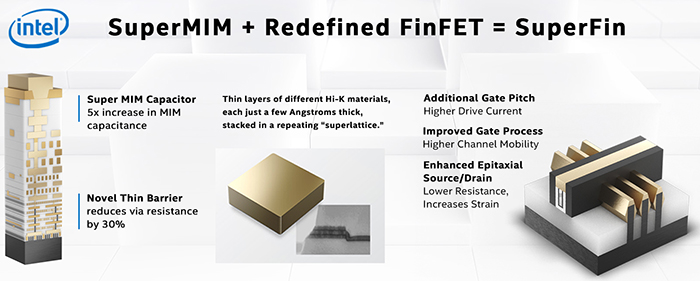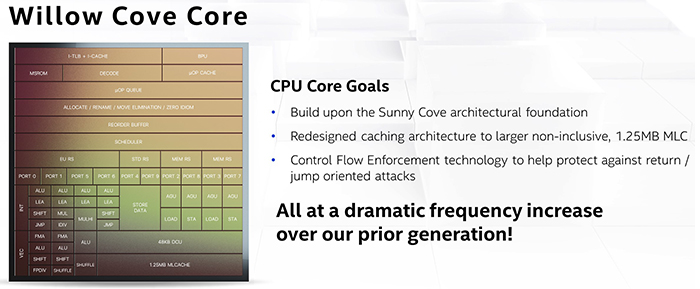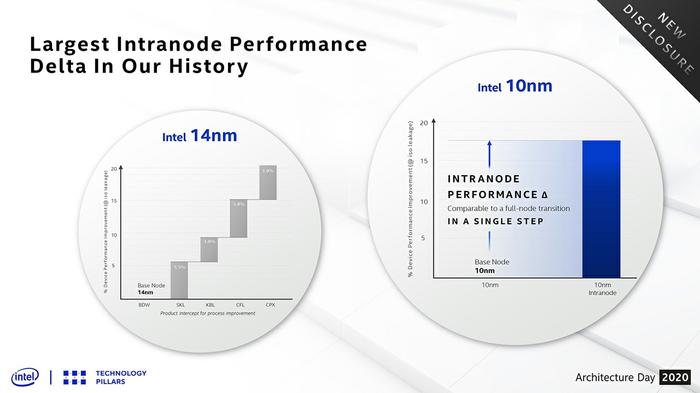Intel has wrapped up its Architecture Day 2020 webcast which was stuffed with information on new CPU and GPU and related technologies. Probably the biggest announcement of the day was of the new transistor technology dubbed '10nm SuperFin Technology'. Intel refers to this as "the largest single, intranode enhancement in the company’s history," and goes so far as claiming the enhancement delivered is comparable to a full node transition.
In brief, 10nm SuperFin technology is a refinement of FinFET with new SuperMIM capacitors in play (MIM is short for metal insulator metal). Intel debuted FInFET in 2012 with Ivy Lake CPUs, giving it a notable boost at the time. Now it seems to be pitching SuperFin as a tech that can help plug the disappointment gap for customers waiting for its 7nm processors. SuperFin technology offers enhanced epitaxial source/drain, improved gate process and additional gate pitch, which are claimed to deliver greater performance by:
- Enhancing epitaxial growth of crystal structures on the source and drain, thus increasing strain and reducing resistance to allow more current through the channel.
- Improving gate process to drive higher channel mobility, which enables charge carriers to move more quickly
- Providing an additional gate pitch option for higher drive current in certain chip functions that require the utmost performance
- Using a novel thin barrier to reduce via resistance by 30% and enhance interconnect performance
- Delivering a 5x increase in capacitance within the same footprint when compared to industry standard, driving a voltage droop reduction that translates to dramatically improved product performance. The technology is enabled by a new class of 'Hi-K' dielectric materials, stacked in ultra-thin layers just several angstroms thick to form a repeating 'super lattice' structure. This is an industry-first technology that is ahead of current capabilities of other manufacturers.

Willow Cove and Tiger Lake
Willow Cove is the new CPU microarchitecture from Intel and it employs SuperFin technology. Thanks to this improvement and the foundation of the Sunny Cover architecture, Willow Cove "delivers more than a generational increase in CPU performance with large frequency improvements and increased power efficiency," asserts Intel. With Willow Cove comes a new caching architecture for better performance with those all-important security enhancements.

Today Intel takes the Willow Cove cores for optimised CPU performance, adds in AI accelerators - and creates Tiger Lake - the first Intel SoC to come packing Xe-LP graphics on board. Thus, as well as the above flagged general compute prowess, it delivers "massive AI performance improvements, [and} a huge leap in graphics performance," according to Intel's own tests. Thunderbolt 4 is another of this processor's many charms, which include:
- New Willow Cove CPU Core – with significant frequency uplift leveraging 10nm SuperFin technology advancements.
- New Xe graphics with up to 96 execution units (EUs) with significant performance-per-watt efficiency improvements.
- Power Management – Autonomous dynamic voltage frequency scaling (DVFS) in coherent fabric, increased fully integrated voltage regulator (FIVR) efficiency.
- Fabrics and memory - 2x increase in coherent fabric bandwidth, ~86GB/s memory bandwidth, validated LP4x-4267, DDR4-3200; LP5-5400 architecture capability.
- Gaussian Network Accelerator (GNA) 2.0 dedicated IP for low power neural inferencing offloading from the CPU. ~20% lower CPU utilization on GNA vs. CPU (running noise suppression workload).
- IO - Integrated TB4/USB4, integrated PCIe Gen 4 on CPU for low latency, high bandwidth device access to memory.
- Display – Up to 64GB/s of isochronous bandwidth to memory for multiple high-resolution displays. Dedicated fabric path to memory to maintain quality of service.
- IPU6 – up to six sensors with 4K30 video, 27MP image, up to 4K90 and 42MP image architectural capability.

Other Intel Architecture Day news
In addition to the above, Intel confirmed that it was advancing to a hybrid architecture with its upcoming Alder Lake. This takes the baton from the Lakefield processors which debuted recently and will bring the tech to larger devices such as traditional laptops.
In the data centre, Intel claims that its Ice Lake parts, the first 10nm Xeon Scalable processors, will arrive towards the end of 2020 and deliver benefits such as total memory encryption, PCIe Gen 4, eight memory channels, and instruction set enhancements that speed up cryptographic operations.
Sapphire Rapids will succeed Ice Lake to deliver SuperFin tech to the data centre and additional benefits such as DDR5, PCIe Gen 5, and Compute Express Link 1.1.
… new Intel Xe graphics details up next …







